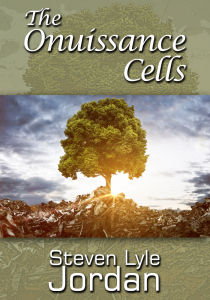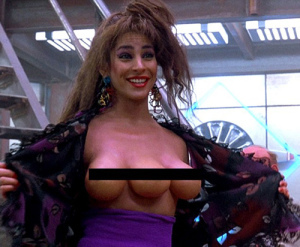Steven Lyle Jordan's Blog, page 23
November 23, 2015
Jessica Jones: Superhero Noir is powerful stuff
 Jessica Jones, the new series on Netflix, is Marvel’s latest foray into the televised (well, streamed) world of superheroes. And honestly, it’s different. Although the main character has special powers, that’s really not what she, or the series, is about.
Jessica Jones, the new series on Netflix, is Marvel’s latest foray into the televised (well, streamed) world of superheroes. And honestly, it’s different. Although the main character has special powers, that’s really not what she, or the series, is about.
Jessica makes her living as a private investigator, struggles with personal failures, and seeks comfort in old and new friends. But wait, she’s a superhero: Why not work at superheroing? Because Jessica suffered a trauma at the hands of a madman who can control other people’s minds… and it was so bad that she gave up superheroing. Yeah, she’s not the paragon of virtue with the “never surrender” attitude of a Captain America; she’s just a girl trying to get along, and so broken by her past that she only wants to forget it ever existed. So she does her job, drowning her memories in booze and keeping everyone at a distance with her smart mouth and cynical attitude.
This is noir detective drama. And it’s seriously great stuff.
 What’s great about this is that her troubled past has turned her into the penultimate cheap private dick, a female Sam Spade with an office-slash-apartment, a junkie neighbor and a new love interest that she first saw when following a client’s cheating wife. Jessica has incredible strength, and the ability to jump at least a few stories into the air—making her a lower level superhero, at least compared to the Avengers—but at times, the viewer can completely forget that. Jessica herself downplays it (or teases people with it, She uses her powers to help her do her job, and occasionally to defend herself or others… but mostly she gumshoes around New York City, pursuing cases for clients, researching on the web, grudgingly asking for help from her few contacts when she needs it, and solving the occasional crime.
What’s great about this is that her troubled past has turned her into the penultimate cheap private dick, a female Sam Spade with an office-slash-apartment, a junkie neighbor and a new love interest that she first saw when following a client’s cheating wife. Jessica has incredible strength, and the ability to jump at least a few stories into the air—making her a lower level superhero, at least compared to the Avengers—but at times, the viewer can completely forget that. Jessica herself downplays it (or teases people with it, She uses her powers to help her do her job, and occasionally to defend herself or others… but mostly she gumshoes around New York City, pursuing cases for clients, researching on the web, grudgingly asking for help from her few contacts when she needs it, and solving the occasional crime.
Until the man who ruined her life comes back to New York, and makes it clear in the first episode that he’s out to get her.
This show pushes some powerful buttons, especially in the areas of fear, violation, helplessness, paranoia, isolation and the struggle towards recovery. Because you can honestly feel for Jessica: You see how she struggles with a ruined life, trying to put it back together in a way that’s pretty lousy, but does the job; you fear for her tenuous struggle for sanity, her desire to just forget it ever happened; and her terrifying realization that it might happen, all over again. But despite her fear, she is just as motivated by a rage over her own violation that will show no mercy, to her or anyone; she wants the man who ruined her life, and is determined to prevent him from doing that to anyone else.
And yeah, superhero or not, you definitely get the idea that she’ll kill him if she thinks she has to. And Jessica is just unstable enough that you wouldn’t want to be in her way if she made that decision.
You don’t get much more noir than that.
With a wonderfully believable cast of supporting characters, people doing their best to cope with a world that has superheroes (and supervillains), clever writing, dramatic tension, powerful action and devious twists and turns, this show will leave you captivated, actively looking in every corner of the frame to see if something nasty is lurking there. This is what an adult superhero show, a show about the real-life ramifications of such a dangerous lifestyle, looks like.


November 20, 2015
There really is no such thing as race.
November 18, 2015
Safer, cheaper, more secure, less radioactive nuclear power? Yes, please.
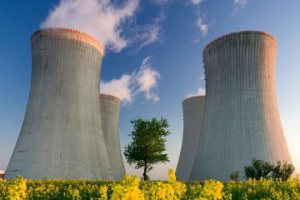 As we creep sprint closer and closer to our global warming tipping point, some countries are seeking viable alternatives to the dirty oil- or coal-fired power plants and oil-based engines that power our economy.
As we creep sprint closer and closer to our global warming tipping point, some countries are seeking viable alternatives to the dirty oil- or coal-fired power plants and oil-based engines that power our economy.
It’s gratifying and encouraging that so many countries are adopting alternative energy solutions like solar, wind and geothermal power plants, at industrial and single-home levels, and are making a significant impact on global warming. But other countries and regions have decided that nuclear energy is the way to go. And unfortunately, today’s heavy water-based, uranium-powered plant designs have a host of problems—mainly accident and radioactive waste risks—that make them highly undesirable to most of the population.
But what if I told you there was a better nuclear power plant design—one that was safer, cheaper, more secure, and even less radioactive than current nuclear plant designs—and that the technology was ready for use, right now? Would you like that?
Sure you would.
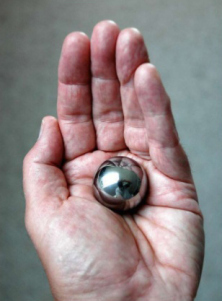
This thorium ball holds enough energy to supply an individual for a lifetime (based on average use per person in the USA).
A Popular Science article in June, 2011 described a nuclear power plant using the molten-salt system (an MSR reactor) and powered, not by uranium, but by thorium—a safer, more plentiful and less radioactive element than uranium. The thorium-based MSR was experimented with back in the latter half of the 1960s, and proved itself superior to uranium-powered designs in many ways:
MSR reactors use very simple means to shut down the reaction in the event of a problem, making it more meltdown-proof than any other existing reactor design;
Thorium is four times as abundant as uranium and is easier (and therefore cheaper) to mine, in part because of its lower radioactivity;
One pound of thorium produces as much power as 300 pounds of uranium–or 3.5 million pounds of coal;
Thorium is 99% burned in a nuclear reaction, compared to 3% of uranium, creating significantly less waste;
Thorium is not fissionable after use in a reactor, making it useless for weapons applications;
Thorium waste radioactivity lasts a few hundred years, versus uranium’s tens of thousands of years.
A thorium-powered plant is also significantly smaller, easier and cheaper to run than uranium-based plants, meaning there can be more of them, and they can be closer to urban areas where the power is needed… even multiple plants servicing an urban area by districts. An entire plant can fit on a city block or two: It doesn’t outwardly look like a traditional nuclear plant, with all of its massive cooling towers and storage containers; and it can be encased in a more traditional building facade to make it blend in to the neighborhood.
In fact, it’s hard to decide what’s the best feature about a thorium-based MSR: The fact that it generates less radioactive waste, which stays radioactive for a much shorter time frame; the fact that it’s an inherently safer design, much less likely to suffer a catastrophic failure compared to uranium-powered plants; or the fact that it produces no weapons-grade byproducts. But one thing is sure: If ever there was a better alternative to coal- and oil-based power systems, nuclear is it… safe nuclear is it in spades… and thorium-based MSRs sound like exactly what we need.
I’d even go so far as to recommend that the US not only promote it’s design, but assist every developing and developed country in assembling their own thorium-based MSRs, which would not only help those countries to develop, but would do so without adding to global warming or creating weapons-grade fissionables that threaten national (and global) security.
Think about it: If the US had gone to Iran and offered to assist in building thorium-based MSRs, there might be less (or maybe even no) concern today about Iran’s creating and stockpiling fissionables for use in weapons. And it probably wouldn’t hurt the US’ image if other countries knew we were switching from uranium to thorium plants, and producing less fissionables ourselves. Think of how many countries this move might’ve helped to stabilize, as well as improving US standings worldwide.

The Capitol Power Plant in Washington, DC; old energy tech, blocks from the Capitol, and ripe for replacement with a thorium-based MSR.
To get things kick-started, a new pilot project is in order; and if the US wants to initiate a demo program, proving the system’s worth and the government’s confidence in it, I have the perfect suggestion: There’s the ancient coal-fired Capitol Power Plant near the US Capitol in Washington, DC, chugging out soot as fast as it chugs out power for that venerable institution. That plant could be replaced with a newer, cleaner, safer thorium-based MSR, providing power to the Capitol and the surrounding neighborhood and proving its capability (and the US government’s confidence) to the world.
Unfortunately, few outside of experts and engineers know much about thorium-based MSRs, or their significant differences to other nuclear plants; and because the country adopted uranium-based plants in the sixties, there are no guidelines or regulations in place for building and maintaining thorium-based MSRs, holding back their support and development. A significant education program needs to be put in place, so the public and the government will know about this technology and its advantages, and will then push to implement it, especially in areas where our existing uranium-based plants are aging, decaying and pushing (or already pushed past) retirement.
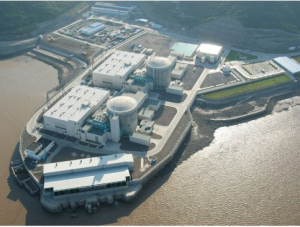 It’s understood that we should not pass up on using alternatives like solar, wind, tidal and geothermal energy wherever we can, and actively finding new ways to conserve and more efficiently use energy. But in situations where nuclear power may be more practical or desirable, we should be switching to safer, cleaner, cheaper, more secure thorium-based MSR plants, asap.
It’s understood that we should not pass up on using alternatives like solar, wind, tidal and geothermal energy wherever we can, and actively finding new ways to conserve and more efficiently use energy. But in situations where nuclear power may be more practical or desirable, we should be switching to safer, cleaner, cheaper, more secure thorium-based MSR plants, asap.


November 15, 2015
Star Trek is as out-of-date today as Buck Rogers was in 1980. (Take the hint.)
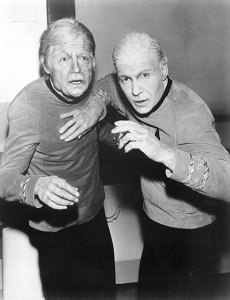
“The Deadly Year” must be 2017.
With all the talk about bringing back a Star Trek series for its 50th anniversary, I find myself regularly reminding people that—yo—Star Trek is 50 years old! Why bring it back?
This might not be a big deal for your average franchise, in which it’s nothing to simply modernize the cast and setting, and carry on. But Star Trek is science fiction, its universe based strongly on the popular attitudes about science, technology and the future as envisioned in the 1960s. We’ve learned a lot about science and technology since then, which completely upends the universe envisioned by Star Trek.
Which makes Star Trek‘s impact on modern audiences the equivalent of Buck Rogers’ impact on the audiences of my age, back in 1980.
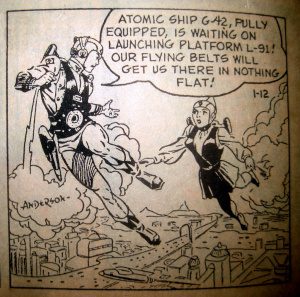
Buck Rogers: This was sci-fi in 1928.
Buck Rogers was the hero of a comic strip written and drawn by Philip Francis Nowlan, back in 1928. It, too, was an embodiment of the popular attitudes toward science, technology and the future, and it was hugely popular in its day. It soon inspired movie serials starring ex-Olympiate athlete Larry “Buster” Crabbe, which ran for years in cinema.
In 1970, when television was growing in dominance and stations were looking for “filler content” to put on in non-prime-time slots, old movies and movie shorts became popular fodder for daytime television, especially on channels aimed at kids. Alongside movies like The Bowery Boys and shorts of The Three Stooges, the Buck Rogers serials would air on a regular basis.
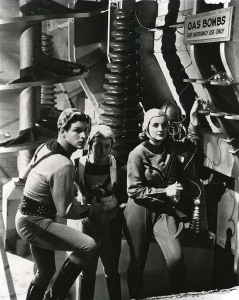 But America had already put a man on the Moon. Star Trek, in fact, was already on television. And against the more modern Star Trek and the reality of the Apollo program, Buck Rogers in 1970 may have been a shot of nostalgia to our parents and grandparents… but to us kids, it was a kitschy bunch of hilarity.
But America had already put a man on the Moon. Star Trek, in fact, was already on television. And against the more modern Star Trek and the reality of the Apollo program, Buck Rogers in 1970 may have been a shot of nostalgia to our parents and grandparents… but to us kids, it was a kitschy bunch of hilarity.
The renewed interest in sci-fi nostalgia reared its ugly head in 1979, after a fairly popular movie called Star Wars had prompted every studio to search for sci-fi material to throw onto the bandwagon. Universal Studios had already developed Battlestar Galactica, and using many of the same production houses, brought back their old hero Buck for a new TV series.
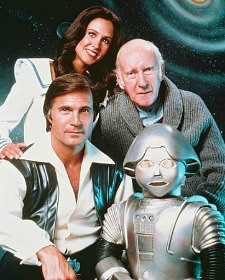 But despite the just decent production work, Buck Rogers didn’t catch with audiences: The mix of cheesy characters, childish humor, aliens in name only, and the hackneyed mad-monarchy-taking-over-the-world zeitgeist, the show held no attraction to modern audiences. A series that had been invented fifty years previous had completely outlived its relevance, and it died a quiet death in two seasons.
But despite the just decent production work, Buck Rogers didn’t catch with audiences: The mix of cheesy characters, childish humor, aliens in name only, and the hackneyed mad-monarchy-taking-over-the-world zeitgeist, the show held no attraction to modern audiences. A series that had been invented fifty years previous had completely outlived its relevance, and it died a quiet death in two seasons.
Fast forward to 2017, when Paramount plans to release a new Star Trek series, which will take advantage of some of the things that made Star Trek such a phenom in the 1960s—don’t bet on any of the political or social controversy, or much time spent examining science and technology and its impact on our lives, that made Star Trek famous; modern audiences just aren’t interested in that.
What’s left, you ask? Klingons, phasers, transporters and primary-colored uniforms. Romantic notions like cruising through space as easily as a naval vessel cruises the Mediterranean Sea, showing our intelligence and superiority to lesser alien species that all seem to share our problems. These are notions that people could readily accept in the 1960s; but today, they are quaint concepts that have been outdistanced by present knowledge. Multitudes of humanoid aliens and sailing the vastness of space on matter-antimatter power are no longer the future we expect to be waiting for us.
And as Paramount will want to make the show even more palatable to modern audiences, they’ll mine all the popular TV tropes for their show, including YAs and romances, back-stabbing secrets, pointless rivalries, mysterious pasts, addictions, spies and hidden agendas. (You know: The stuff that makes today’s television so compelling.) The resulting mix would be a travesty of galactic proportions, making the new show look archaic and ridiculous, and prompting derision from modern audiences.
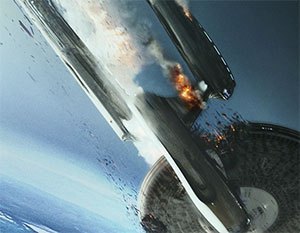 As much as I loved the science fiction phenomenon that is Star Trek, I can see that it’s time to retire the Federation and its citizens once and for all. The last two movies have proven that attempting to update the franchise has taken the Star Trek right out of it, and left it a shadow of its former self, trying desperately to mine its past glory. After 50 years, any new Trek-based TV show will be Buck Rogers all over again: A show behind its own time, a disappointment to both audiences and Paramount.
As much as I loved the science fiction phenomenon that is Star Trek, I can see that it’s time to retire the Federation and its citizens once and for all. The last two movies have proven that attempting to update the franchise has taken the Star Trek right out of it, and left it a shadow of its former self, trying desperately to mine its past glory. After 50 years, any new Trek-based TV show will be Buck Rogers all over again: A show behind its own time, a disappointment to both audiences and Paramount.
Trek shouldn’t be forced to perform well past its prime, so someone else can sell toys and stuffed aliens. Better to create a brand new franchise for the 21st century, and let Star Trek retire (I would add “gracefully,” but it’s too late for that).


November 9, 2015
Ecotopia: Solarpunk… before it was a thing
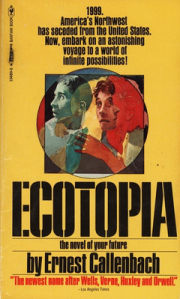
The original paperback cover of Ecotopia, the design of which I still don’t get.
In recent years, the term “Solarpunk” has been batted around: A new kind of science fiction written around renewable, sustainable energy, embracing the natural world and an optimism for the future. Project Hieroglyph has recently used the term, leading some to believe it’s a relatively new thing. Others have pointed out novels written in the mid-90s that were purportedly the earliest Solarpunk novels.
Back when the first George Bush was assuming the White House, the Exxon Valdez was ruining the lives of countless Alaskan creatrures and William Shatner was busy hammering his nails into the coffin that was Star Trek V, I, myself, wrote a series of short stories called The Onuissance Cells.
But none of these examples were the first to the party. To see the original Solarpunk novel, you go straight to Ernest Callenbach’s Ecotopia.
Ecotopia (original publishing: 1975) tells the story of reporter William Weston, given the chance to travel from typically dirty, gritty, nasty and polluted New York to the newest country on the American West Coast, Ecotopia; and by interviews and his own daily diary, describe what life is like in a country dedicated to natural and sustainable lifestyles. Through Weston’s eyes, we discover the efforts made for the denizens of the combined states of northern California, Oregon and Washington to throw off the unnatural and polluting practices of late-20th century America and embrace a new culture, and a way of life that at first seems practically barbaric to Weston, but begins to grow on him the longer he stays.
I had the pleasure of reading this book when it came out in the seventies, and when combined with my already-budding interest in alternative energy, back-to-nature methodologies and sustainable living, it became a transformative experience for me. (If you haven’t read this book, I highly recommend it.) Ecotopia embodied the movement against the existing oil-based, dirty, unhealthful and wasteful conventions of society and promoted individual, dedicated efforts towards a natural, positive, clean and sustainable lifestyle. Today it is still held in high regard as a virtual blueprint towards a better society, and has even garnered support for the creation of an actual Ecotopian country on the American West Coast. Ecotopia was Solarpunk, long before the name was coined.
Ecotopia, combined with my own interest in alternative energy and sustainability, and the growing popularity of architect Paolo Soleri’s Arcology movement, were inspirations for my short stories, The Onuissance Cells. The stories take place in a future when Man has dismantled the old, crumbling, inefficient society and rebuilt it around sustainable and natural practices, gentler on the land, with a full appreciation for nature and a dedication to rebuilding our human-ravaged world. (Check them out; they’re free.) Some of the ideas from my stories are taken from Ecotopia, but mixed in with many of the technological advances that have been discovered since 1975.
The Onuissance Cells represent my imagining for what the next age of humanity will be, once we grow past the society that is on life support today. As we reach “peak oil,” many fear we’ve reached other peaks too, like peak agriculture and peak diversity… and we’re soon to see worldwide hunger and a significant loss of animal and vegetable life if we don’t reverse the trends. In fact, factions of this society are beginning to question whether the Capitalist economy is a relic of the 20th century, and overdue for retirement along with our dysfunctional consumption habits and wasteful ways. The Onuissance Cells, like Ecotopia, explored the future possibilities of guaranteed living wages, human-scale architecture and technology, and lives centered around living for experiences… not working for money.
I would love to see Ecotopia made into a TV miniseries; for one reason, because so many people will never read the book; and for another, because I think people should see for themselves examples of a different way of life, one that they can actually strive for. And I suspect that, if Americans had a chance to see a functioning society like Ecotopia, they’d put some serious effort into pressuring our leaders into taking the rest of the country in the direction of Ecotopia… before it’s too late.


November 7, 2015
Mythbusters: That’s how you promote science
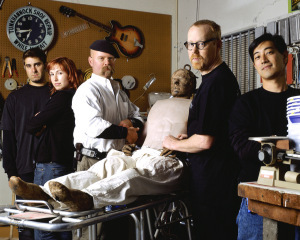 A New York Times editorial, What We Owe the Mythbusters, does a great job of describing the incredible job the iconic show Mythbusters has done to further the interest of science in modern American society.
A New York Times editorial, What We Owe the Mythbusters, does a great job of describing the incredible job the iconic show Mythbusters has done to further the interest of science in modern American society.
Americans have worried about the state of science literacy in our country since the days of Sputnik. Educators who want to improve our prospects in this field would do well to take a few pages from the “MythBusters” handbook.
At a time when interest in science in the U.S. was at an almost all-time low, hosts Jamie Hyneman and Adam Savage, together with their many associates and occasional guests, showed their audience not only how science worked to solve problems and answer questions and myths… but how much fun it was to do it. The show will end its run after 14 seasons, 2,950 separate experiments and an unmeasurable amount of enjoyment and lessons learned by its enthusiastic fans.


November 5, 2015
Technophobia: The American disconnect
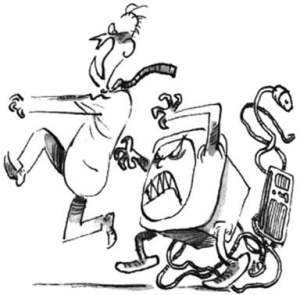 Carl Sagan once said: “We live in a society exquisitely dependent on science and technology, in which hardly anyone knows anything about science and technology.” And only this can explain a Motherboard article that contends a third of Americans think technology will ruin their lives.
Carl Sagan once said: “We live in a society exquisitely dependent on science and technology, in which hardly anyone knows anything about science and technology.” And only this can explain a Motherboard article that contends a third of Americans think technology will ruin their lives.
My initial thought, upon reading the headline of the article, was: Only a third? Because, based on my personal experience, my observations of people and the popular media they consume, I’d think that figure was well over half of the American public.
Part of that is because, as Sagan said, Americans today are largely divorcing themselves of the desire to even know how science and technology works. Despite the fact that they benefit from thousands of years of accumulated knowledge on a minute-by-minute basis, they don’t care if they don’t know how it works (as long as they have enough money to buy, fix or replace it). And when it comes to science and technology, what you don’t know can really hurt you. Faced with a world of technology they don’t understand, it’s easy to develop technophobia and jump to the conclusion that it’s all essentially hazardous.
Another part is, frankly, the sheer complexity of modern life: When you’re balancing a home life, a social life, work, finances, security, health and appearance… adding the details of physics to your vault of knowledge becomes hard. So, again, they are reduced to not trusting science and technology, because they won’t take the time to understand them.
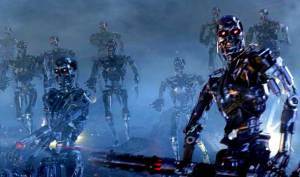 All the same, how is it that so many people can believe that driverless cars, lab-grown meat, brain implants and drone deliveries will “ruin their lives”? How is it that so many people are afraid of the robopocalypse, believe any aliens we someday meet will only want to eradicate/subjugate/eat us, see wars as inevitable and unstoppable, or are just as sure an undetected asteroid will wipe us out any minute now?
All the same, how is it that so many people can believe that driverless cars, lab-grown meat, brain implants and drone deliveries will “ruin their lives”? How is it that so many people are afraid of the robopocalypse, believe any aliens we someday meet will only want to eradicate/subjugate/eat us, see wars as inevitable and unstoppable, or are just as sure an undetected asteroid will wipe us out any minute now?
I blame the media for our national technophobia.
Which sounds far too simplistic, I know, but nonetheless: American commercial media (primarily television, movies the web and social media) does more to shape the attitudes of the American public than any other single influence, including parents, schools and peers. And it’s American media that shows us technology-run-amok on a constant basis, from real life stories of crashed planes, drone missile strikes and DNA experimentation gone bad, to fictional terminators, cloned T-Rexes, Star Wars and nuclear apocalypse.
Precious few are the TV shows, movies or news reports about science and technology applied to solve problems and make our lives better. Precious few in the media talk about the thousands of jet flights that land safely and successfully every day. Precious few in the media talk about the thousands of lives saved in hospitals and clinics (including my father), the lives saved by seatbelts and airbags (including my mother), or the countless lives saved or just made better, richer or happier thanks to our telecommunications-connected world.
They do talk about zombies, ax murderers, terrorists and hackers. They invent implausible scenarios to scare the public about innovations and improvements to their lives. They lampoon the changes that technology brings to daily life, and present them as nightmares. They invent and exaggerate statistics to convince those (who don’t know how to read or check statistics) that positives are, in fact, deadly negatives. They are the ones who wait for people to get Future Shock… then they press them with the joy buzzer.
The media doesn’t want to understand science and technology, either… because it’s already convinced that the public wants to be ignorant. So they sell sensationalist material designed to pander to that intentional technophobia. If a third or more of Americans see doom and gloom as the inevitable result of science and technology… it’s the media that quite deliberately put it there. Faced with a beautiful forest, the media has people seeing only the thorn bushes and poison ivy on the forest floor.
But it’s a funny thing with science and technology: It’s easy to lose sight of exactly how good you have it. And people who live everyday with automobiles, computers, cellphones, aircraft, electric lights, online shopping, credit cards, direct deposit and ipods, seem to easily forget how much those things, and others, have improved their lives so significantly. At one time, these new things heralded a change to our lives, which can be concerning, scary… yes, even ruinous. But generally speaking, our world has been enriched by those changes; there really are very few examples of technological advances that have made the world worse, despite the claims of the media.
Those of us who are not so susceptible to the negative vibes of the media need to do more to highlight and encourage the positive side of technology. We need to make sure people are aware of the ways in which their lives are being enriched by technology; as well as all the negative predictions of what technology would bring over the years, that never actually happened. Instead of indulging others’ technophobia and predictions of doom and gloom, remind them of how unlikely it would be that they’d even be here to consider their fate, without the benefits of the technology that got us here.
Most importantly, show them how valuable it is to know how the world works, and how well that mitigates so much of the doom and gloom that’s based on scientific and/or technological ignorance. (No, don’t call them ignorant. Show them how knowledge about science and technology can chase away the fears of things that can go wrong.)
Too many of the technologies that can positively transform this world are delayed, or even given up, thanks to people who are afraid of what they don’t understand. The best way we can get ahead is to make sure everyone understands, not only how something works, but what is at stake… so we can all make decisions based not on fear or technophobia, but on truth.


November 2, 2015
A NuTrek series is coming. Whoo.
Yes, it’s all over the interwebs, and making geek waves all over: The announcement that a new Star Trek TV series will be coming to us in 2017. And I’m really not looking forward to this…
And I’m really not looking forward to this…
Not because I wouldn’t like to see a new Star Trek TV series… but because it’s reportedly going to be helmed by the people who gave us the last two Star Trek movies.
Yeah. The ones where Kirk is an utter asshole, Spock is an unbalanced psycho, ships are big enough to play pro football in the rec rooms, communications looks remarkably like a brewery and engineering has more plumbing than a Soylent factory… well. You get the gist.
Yeah, I’m a Trek purist… I admit it. In my Star Trek, the crew of the Enterprise was about exploration, learning about the galaxy and other cultures, and helping people with their problems. They did everything they could to avoid wars and conflicts, or to end them with as little bloodshed as possible, and come to peaceful understandings with alien races.
But in later years, Star Trek became about this:
 It was Star Wars, but with the Empire as the good guys.
It was Star Wars, but with the Empire as the good guys.
The NuTrek movies used one of science fiction’s worst tropes—time travel creating alternate timelines—as an excuse to do whatever they wanted with the original Star Trek characters, and turned them into the kind of people audiences would recognize from a primetime soap: Jerks, prima-donnas, morons, jokers and troublemakers, who are more predisposed to getting into elaborately-choreographed fights or unloading their arsenals on their enemies as working out peaceful solutions to anything. Its producers were allowing the nation’s fondness for first-person shooters to overwhelm ideas like thinking through problems and forging peace through cooperation, and were more interested in Kirk’s sex life with green-skinned aliens than his abilities as a diplomat and representative of the Federation is general, and the Human race in particular.
And I imagine we’ll have plenty of this to look forward to:
This is not my idea of Star Trek. This is pandering to tired old sci-fi cliches, and even more tired Star Trek cliches, in order to create titillation and stoopid crazy space-battles to thrill an audience that doesn’t want to think beyond the last pizza they ordered online. This is a parody of what Star Trek is.
And so, knowing that these are the people who are going to guide the development of the next iteration of Star Trek, I plan to steer in another direction. You guys want to do Star Trek: Travesty, go right ahead. I’ll be an another room, with a book. Or watching a movie. Or walking along the lakeside. Taking a drive. Anything but watching a NuTrek series.
So… prove me wrong. I dare you. I double-dog dare you.


November 1, 2015
OMG… I can READ again.
 No, you don’t understand. I can really read again. For the last two years, I’ve been subsisting on magazines, television and movies, writing on my blog and reading a lot of Facebook, because I couldn’t pick up a novel. But now, finally, I can open a novel and actually read it again.
No, you don’t understand. I can really read again. For the last two years, I’ve been subsisting on magazines, television and movies, writing on my blog and reading a lot of Facebook, because I couldn’t pick up a novel. But now, finally, I can open a novel and actually read it again.
Okay, fine, I don’t sound like I’m making sense. Sooo… explanation follows…
Set the Wayback machine to 2013, when I was a few months after the release of my last novel… and looking at flat-lined sales. It was mucho frustrating: After over a decade and sixteen books produced, nothing was selling worth a damn, including my latest and greatest novel, of which I’d applied every promotional tool at my disposal (which amounts to not bloody much)… to no avail.
And I was telling myself: Well, if no one’s buying your books… what the hell are you doing writing them?
So I came to the decision that I wouldn’t write any new novels, unless and until I could work out the problems of promotion of the novels I’d already written… a forced moratorium on novel writing, until I figured out how to sell. I stopped thinking up new premises, outlining, concept development… everything. And I was good with it. Not quite jiggy with it… but good.
But I soon discovered that, whenever I picked up a novel to read, I couldn’t actually pay attention to what I was reading. I found myself over-analyzing every line and every word, comparing them to my books, and continually asking myself: Are there some things about this writer’s characters that are better than mine? Is it the way this writer turns a phrase, right here? Or the way that writer builds his story, there? Just what is it about this guy’s book that makes it so popular, while my books are invisible?
 Yes, novels had come to mean nothing to me other than being products to compare my own products to. Meaningless objects. And at that point, I had to stop reading them; after all, if I couldn’t enjoy the book, there was little point to reading it. Literally the only book I’ve managed to slog through and actually get, in the last two years, was Weir’s The Martian. And even then, just as astronaut Mark Watney was science-ing the shit out of surviving Mars, I was analyzing the crap out of creating a successful book. (Spoiler: Mark does better with his task than I did with mine.)
Yes, novels had come to mean nothing to me other than being products to compare my own products to. Meaningless objects. And at that point, I had to stop reading them; after all, if I couldn’t enjoy the book, there was little point to reading it. Literally the only book I’ve managed to slog through and actually get, in the last two years, was Weir’s The Martian. And even then, just as astronaut Mark Watney was science-ing the shit out of surviving Mars, I was analyzing the crap out of creating a successful book. (Spoiler: Mark does better with his task than I did with mine.)
Any other attempt to read a book became an exercise in turning pages. Both ways… because I regularly found myself paging back to figure out what I’d just passed my eyeballs over, while my brain was out to lunch agonizing over the book’s creative use of prepositions or wondering if the author was maybe related to a publisher or somesuch.
So, in the interest of maintaining what little sanity I have, I stopped reading books as well as writing them. Sure, I kept myself busy on little things… new covers, short stories, blog posts, contributions and conversations on Facebook. But my oldest and dearest hobby, enjoying a good story, had been taken from me. My mind wasn’t right.
It’s taken me two years to get my head back on track, to the extent that I was finally able to pick up a book this week. And after getting through (so far) about a quarter of the book, not only am I not obsessing with the author’s every use of a pronoun, or the relative benefits of writing a first-person narrative… I am recalling great moments from past books in the series, getting emotional with the main character and his plight, and even laughing out loud at the right places. (Lordy, how I loves me some Harry Dresden.)
 So, I have my hobby back. I also have a backlog of books to get through… y’know, just about 2 years’ worth. But now that I’m no longer snow-blinded by the crass commercial aspect and marketability of books, I can at least relax and be entertained by them once more. Does this mean my head is completely mended from its obsession over book structure, placement, marketing and production? Well, maybe not completely. But as long as I can enjoy a good book… I won’t lose so much sleep over not creating them.
So, I have my hobby back. I also have a backlog of books to get through… y’know, just about 2 years’ worth. But now that I’m no longer snow-blinded by the crass commercial aspect and marketability of books, I can at least relax and be entertained by them once more. Does this mean my head is completely mended from its obsession over book structure, placement, marketing and production? Well, maybe not completely. But as long as I can enjoy a good book… I won’t lose so much sleep over not creating them.


October 26, 2015
Self-driving cars: The FALSE dilemma
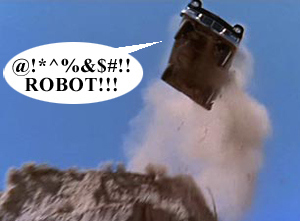 As soon as new technologies come along, the public immediately dials up their natural fear of all things technologic, and start imagining all the things that can go wrong. This technophobic trend has naturally been extended to the concept of the self-driving car. As soon as the possibility of self-driving cars entered the public consciousness, people started imagining assuming that those evil robot cars would make buggy, counterintuitive decisions in every case, causing the deaths of hordes of innocent citizens on a daily basis. (Totally unlike, say, the hordes of innocent citizens killed by human drivers on a daily basis.)
As soon as new technologies come along, the public immediately dials up their natural fear of all things technologic, and start imagining all the things that can go wrong. This technophobic trend has naturally been extended to the concept of the self-driving car. As soon as the possibility of self-driving cars entered the public consciousness, people started imagining assuming that those evil robot cars would make buggy, counterintuitive decisions in every case, causing the deaths of hordes of innocent citizens on a daily basis. (Totally unlike, say, the hordes of innocent citizens killed by human drivers on a daily basis.)
The current trend along these lines is to place self-driving cars in “ethical” dilemmas, to illustrate their inherent danger to their human occupants and obstacles… this Phys.org article is a standard version of this trend.
But just about every scenario imagined has been based on a false dilemma, a blatant exaggeration of possibilities that even a sixth grader should be able to see past.
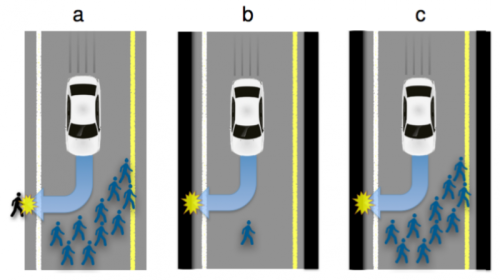 The illustration above shows a typical scenario given a self-driving car: Upon the sudden appearance of a pedestrian or crowd in the street, does the self-driving car:
The illustration above shows a typical scenario given a self-driving car: Upon the sudden appearance of a pedestrian or crowd in the street, does the self-driving car:
swerve to avoid the crowd, even if that means intentionally killing a pedestrian who is not in the road (and presumably not in immediate danger);
swerve to avoid a single pedestrian in the road, even if that means having an accident that injures or kills the car’s passengers; or
swerve to avoid a crowd in the road, even if that means having an accident that injures or kills the car’s passengers?
The question basically assumes there are no better solutions, and the car will be “forced to make a moral choice” to pick who it must injure or kill.
And that assumption is flat-out wrong.
To begin with, there’s no morality or ethics involved with a self-driving car’s actions to avoid collisions; they are designed to stop as quickly as possible—not to swerve like a maniac driver in a buddy-cop movie. So it’s not going to be deliberating on the comparable value of life of individuals and “choosing” directions in which to swerve.
It must also be noted that in tests of self-driving cars so far—and this has included numerous tests of cars driving on public roads and executing cross-country trips—self-driving cars have already demonstrated exemplary driving prowess, and have covered thousands of miles without causing a single accident. (So far, every documented accident that has involved a self-driving car has been determined to be the fault of another human driver.)
There are two primary reasons for this. First, self-driving cars have comprehensive packages of sensors that give them a highly-detailed knowledge of their surroundings, to a degree much higher than that of the average human driver. Thanks to modern sensors and computers, self-driving cars see more, see it better, see it sooner, and are more completely aware of their surroundings than a human driver is capable of. They are also incapable of being distracted or losing focus, as human drivers regularly do. If there is a danger, it is detected by the car well before a human driver would normally see a danger coming.
Second, the power of the computer means that self-driving cars can react to a danger in milliseconds… or a few thousand times faster than it normally takes a human driver to see a scenario, have it register on their brains as a threatening situation, and react physically. And as a human’s quickest reaction is often a panicked one, regularly making bad impulse decisions in a crisis, the self-driving car is much more likely to make a good decision than a human driver.
In short: Self-driving cars will be better than you. Which leads to the true, realistic solution of the self-driving car in the scenario posed above:
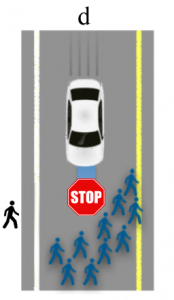 The self-driving car, having identified the danger far sooner than any human driver, has more than enough time to formulate a safe reaction without panicking, executes that reaction perfectly and stops, without causing an accident or hitting anyone. Duh.
The self-driving car, having identified the danger far sooner than any human driver, has more than enough time to formulate a safe reaction without panicking, executes that reaction perfectly and stops, without causing an accident or hitting anyone. Duh.
And sure, there will be the incredibly rare situation when a car will not be able to react and avoid killing someone. But even without bringing morality into the situation, the car will be better able to react and cause a minimal loss of life than any human driver could do in the same situation. This is the reality of the self-driving car and its capabilities: Even in extreme scenarios, the self-driving car will be far safer than a car in the hands of the vast majority of flawed, distracted, slow, impaired and panicky human drivers. Period.
And given this undeniable reality, it continues to amaze me when I hear people insisting that they can drive better than self-driving cars; people actually believe they can see sooner and react better and more effectively than computers, and our roads would be safer without computer-controlled cars on the road. Without mincing words, it’s just plain delusional. We will all be safer when computers do our driving for us; and the sooner we accept that, and do everything we can to accelerate the process of putting us all in self-driving cars, the better off we’ll all be.






